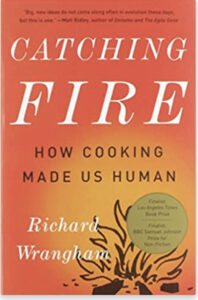“Let food be thy medicine: The Healing Power of Nutrition”
Throughout history, humans have relied on foraging, hunting, and farming to procure the necessary sustenance for our existence. We have drawn from a diverse array of foods found in nature, navigating through experimentation to discover what nourishes us and what may harm us.
In Richard Wrangham’s book, “Catching Fire,” fire is depicted as a pivotal element in the evolution of modern humans. By aiding in the breakdown of proteins and nutrients, fire made these vital components more accessible to our digestive systems. This innovation reduced the time our ancestors spent on procuring, chewing, and digesting food, paving the way for culinary exploration, the development of flavors, and nutritional knowledge.

Plants and animals are remarkable sources of essential nutrients that fuel our bodies and provide defense against environmental challenges. Plants produce Flavonoid Polyphenols with a range of medicinal properties, such as anticancer, antioxidant, anti-inflammatory, and antiviral effects. Other plants rich in Carotenoids combat oxidative stress and lower the risk of various chronic illnesses, including cardiovascular issues, neurological disorders, and type 2 diabetes. Catechin-rich foods, such as chocolate, red wine, and berries, offer a delightful source of nutrients packed with potent antioxidants known for improving vascular circulation along with managing and preventing cancer.
Protein is essential for human life, as it serves as a fundamental building block for cells and the body’s biochemical processes. Proteins can be cultured with probiotics to reduce the presence of cancer-causing agents (Neu5Gc) while enhancing taste and digestibility. Cooking makes the proteins and other nutrients bioavailable.
Carbohydrates impact blood sugar (GI) diversely, from simple structures that immediately elevate your blood sugar, while complex structures evenly fuel our bodies, and fibers which are not even digested. Many carbohydrates contain Lectins, which are naturally occurring proteins considered dangerous, as they increase inflammation, leading to digestive distress and chronic diseases. (Gluten is a lectin). Culinary techniques can transform simple carbs into more stable complex forms while reducing harmful lectins, mitigating their effects.
Fats also play a crucial role in our health, with “bad” fats posing risks to the cardiovascular system while “good” fats offer protection simply through proper selection and temperate utilization. Olive oil, avocado oil, and coconut oil contribute flavor, Polyphenols, and MCT that promote health.
Enlightened chefs have the ability to transform these essential nutrients into bioavailable forms through cooking techniques that our bodies can absorb and utilize effectively. Starting with proper ingredient selection, simple complementary combinations that align isoelectric charges, and pH, advanced bioavailability is achievable. A meal designed with beneficial dish sequencing enhances digestion, manages blood sugar, and supports our palate’s well-being.
Cooking is a vital step in unlocking nutrients to nourish our internal microbiome supporting our Enteric Nervous System and inner well being, fueling our mitochondria, protecting our cells from harmful free radicals, and promoting cell regeneration.
The emerging chefs of today and the future are more than just creators of “pretty plates”; they are our culinary guides to a more fulfilling, nourished life for our bodies, minds, and spirits.

Jimmy Schmidt ©